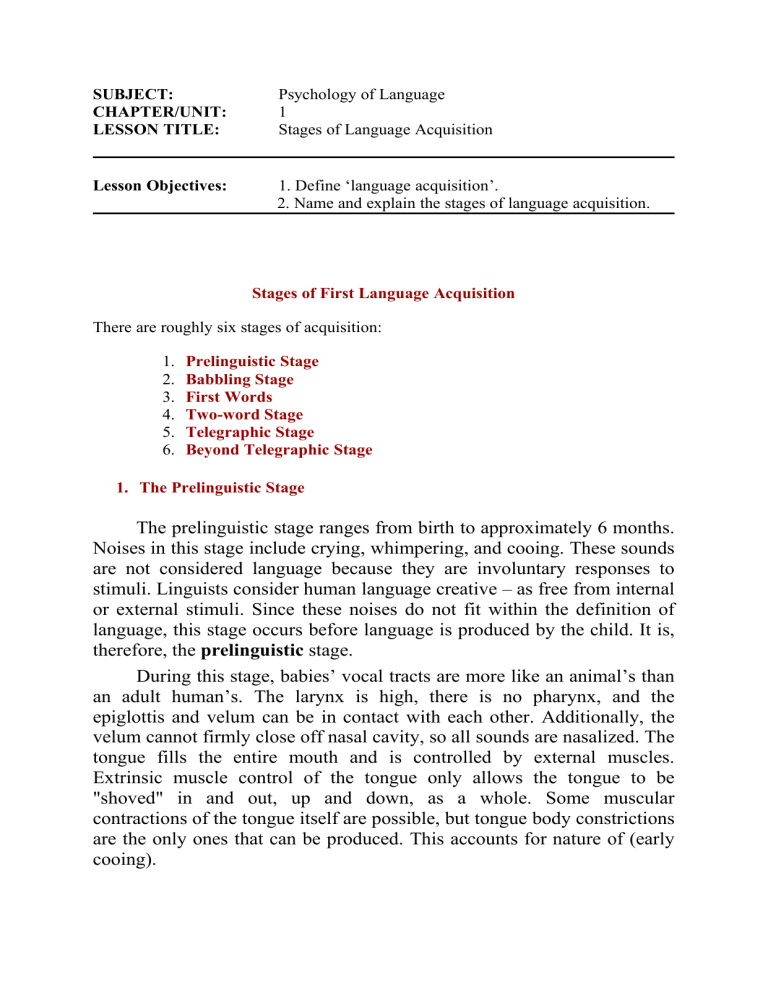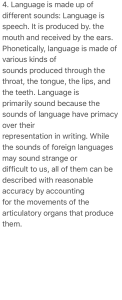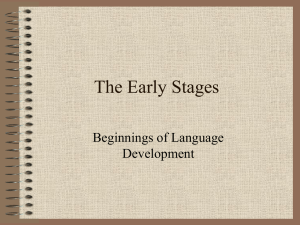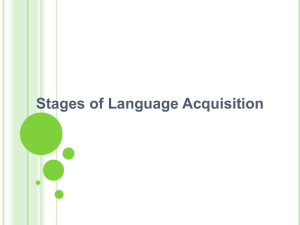
SUBJECT: CHAPTER/UNIT: LESSON TITLE: Psychology of Language 1 Stages of Language Acquisition Lesson Objectives: 1. Define ‘language acquisition’. 2. Name and explain the stages of language acquisition. Stages of First Language Acquisition There are roughly six stages of acquisition: 1. 2. 3. 4. 5. 6. Prelinguistic Stage Babbling Stage First Words Two-word Stage Telegraphic Stage Beyond Telegraphic Stage 1. The Prelinguistic Stage The prelinguistic stage ranges from birth to approximately 6 months. Noises in this stage include crying, whimpering, and cooing. These sounds are not considered language because they are involuntary responses to stimuli. Linguists consider human language creative – as free from internal or external stimuli. Since these noises do not fit within the definition of language, this stage occurs before language is produced by the child. It is, therefore, the prelinguistic stage. During this stage, babies’ vocal tracts are more like an animal’s than an adult human’s. The larynx is high, there is no pharynx, and the epiglottis and velum can be in contact with each other. Additionally, the velum cannot firmly close off nasal cavity, so all sounds are nasalized. The tongue fills the entire mouth and is controlled by external muscles. Extrinsic muscle control of the tongue only allows the tongue to be "shoved" in and out, up and down, as a whole. Some muscular contractions of the tongue itself are possible, but tongue body constrictions are the only ones that can be produced. This accounts for nature of (early cooing). Images from: http://www.unc.edu/~tofu/ling101/loggrab/vt-development.pdf One development in the ability to produce sounds seems to occur in this stage. At about two months, infants seem to be able to coo voluntarily, whereas previously they were only able to make sounds involuntarily. Even though infants can’t produce linguistic sounds, they can perceive them. This stage might more appropriately be called the pre-production stage. Infants alter their sucking patterns when presented with a phonetic distinction in sounds. The alteration in sucking shows an awareness of the change in sound, but infants do not seem to attach meaning to the changes in sounds. They only register that they notice them. This awareness is exhibited as early as one month old. Infants can differentiate between sounds that are allophones in a language that adult speakers of that language have learned to ignore, such as [p] and [ph]. 2. The Babbling Stage The babbling stage begins at approximately 6 months of age and continues until a child is about one year old. One key development leading to babbling occurs during the prelinguistic stage; around 4 months of age, larynx starts to drop, creating pharyngeal cavity. Once the larynx has dropped, more varied constrictions can be formed, which leads to a new stage of vocal play or babbling. The child is also more able to raise and lower the jaw. A lower jaw also lowers the tongue, creating the possibility of more vowels. Raising the jaw allows for more lip and tongue tip constrictions. Source: http://sapir.ling.yale.edu/ling165/ 2 Types of Babbling May Occur: 1. Repetitive babbling - same syllable in each successive cycle 2. Variegated babbling - variation in syllables in successive cycles Text from http://sapir.ling.yale.edu/ling165/ Universality of the Babbling Inventory Essentially, all children use the same sounds when they babble, no matter what the language around them is. "The consonants that occur with substantial frequency in the babbling of infants, regardless of language environment (Locke, 1983) are: /b/ /d/ /g/ /p/ /t/ /k/ /m/ /n/ /w/ /j/ /h/ Vowels in babbled syllables tend to be low front:" /æ/ "or central:" /a/. The universality of babbling makes sense when you realize that the easiest way to make a sound is to simply open and close the mouth. It is not surprising that stops will be highly prevalent in the inventory since they are produced by closing the oral cavity, which happens when closing the mouth occurs. The rest of the difference between the stops is where in the mouth the tongue contacts the other parts of the vocal tract. For example, depending on whether a child rests the tongue on the bottom of the mouth behind the lower teeth or whether it rests in the middle just behind the front teeth accounts for the difference in the production of bilabial and alveolar sounds in babbling. All the child has to do is open and close the mouth, and different sounds will be made. Think of the words (we'll use English here) that we use to refer to many baby items and caretakers: Baba (bottle) Mama (mother) Nana (grandmother) Papa (father) Dada (daddy) These utterances show repetitive babbling of the low central vowel with stop consonants. Now add the high back round vowel: Bubu (hurt) Mumu Nunu Pupu (poopoo) Dudu (doodoo) These utterances also show repetitive babbling, but with a different vowel sound. The two different syllables can be mixed together: Mami (mommy) Papi (Poppy, often used for grandfather) Pupi (poopy) These utterances show variegated babbling. And we’re back to Baby Talk. Baby talk has two different meanings: 1. It is the way that babies themselves talk, and when baby talk is used with this meaning, it refers in particular to the babbling stage and the first words stage of language acquisition, universal stages for all infants in all languages. 2. It is the way that adults talk when they talk to babies. When baby talk is used with this meaning, it captures the fact that adults accommodate their speaking style to that of the child. They help the child attach meaning to their utterances by using the same utterances with the meaning attached. Even deaf children babble.The hand gestures of deaf children occur in repetitive patterns the way that the babbling of hearing children repeats. Deaf children babble in sounds, too, but it seems different than the babbling of hearing children. In other words, deaf children babble in sign language and just make noises with their mouths. Hearing children babble with their mouths, and just make gestures with their hands. For hearing children, language is produced with the mouth, and extralinguistic communication with the hands. For deaf children, language is produced with the hands and extralinguistic communication with the mouth. The Perception of Language During the Babbling Stage infants begin to ignore/lose the ability to distinguish between the sounds of their parents’ (caretakers’) language and other sounds. They respond only to sounds that are the language distinctions of their parents’ (caretakers’) language. In other words, prelinguistic Korean infants respond to the difference between [l] and [r]; children in Arabic environments do the same with [p] and [b]; children in Spanish environments the same with [i] and [I]. But in the babbling stage, they no longer respond to the difference, treating both sounds the same. Remember that this starts at about 6 months of age; the early disappearance of awareness of phonetic distinctions has great implications for second language learning and pronunciation and lends support to the critical period hypothesis for first language acquisition. 3. The First Words Stage Stage 3, the First Words Stage, starts at about one year and continues for approximately 6 to 12 months (up to approximately age 1-1/2 or 2 years old). This stage is also referred to as the Holophrastic Stage because a "one word = one sentence" pattern seems to exist in the utterances produced by the child. Babbling may overlap with the production of the first words, and indeed the first words often exhibit the same structure as babbled syllables, with a CV (consonant-vowel) syllable used as a word. However, at this stage, meaning is attached to the syllables produced by a child, and this characteristic distinguishes a babble from a word. Examples of some first words include: 1. 2. 3. 4. [no] [da] (dog) [ma] (mom) [dæ] (dad). The words produced are primarily noun-like (e.g. [da] (dog), [ma] (mom)) with verbs second (e.g. [go]) and adjectives [ha] (hot)) third. Words also include displeasure/rejection words (e.g. [no]). Words include social interaction words (e.g [bai bai] (bye-bye) [nai nai] (night-night)). As children begin to produce utterances that count as words, they continue to develop their abilities to produce more and more individual sound segments. The sounds they produce are typically sounds in the language of their environment, and they add to their repertoire in a systematic way. Developmental order of sounds articulated: 1. The full range of vowels in the native language is produced before the full range of consonants 2. Consonants are typically added in the following sequence of manner (exampls of sounds in each category come from English): Nasals [m] [n] [ŋ], Glides [w] [j], Stops [p] [b] [t] [d] [k] [g], Liquids [l] [ɹ], Fricatives [f] [v] [s] [z], Affricates[tʃ] [dʒ] 3. Consonants are typically added in a front to back order of place, with certain front sounds being delayed: labials (sounds produced with the lips) come first, then alveolars (sounds produced just behind the teeth), then velars (sounds prodcued near the back of the roof of the mouth), then alveopalatals (sounds produced behind the teeth and a little further back). Interdentals (sounds produced by placing the tongue between the teeth) come last. 4. New contrasts generally show up in the initial position first. That is, when a child adds a new sound segment to his/her repertoire, he/she uses it as the first sound in a word, then puts it in other positions later (i.e., in the middle or at the end of a word). Children can perceive more sound segments than they can produce. As a result, they will often substitute one sound for another in their own utterances. The substitutions or alterations they make are systematic in nature; they will always use the same sound as a substitute for their intended sound, such as always using [w] for [l], producing [wajk] instead of [lajk] for like. The substitutions and alterations make articulation easier until they can develop more control over the vocal tract. As control develops, more sounds are added and a vocabulary is constructed. Stage 4: The Two Word Stage The Two Word stage normally begins at around 18-24 months (1½ or 2 years) and continues for several months, perhaps shifting into the next stage at about 2½ years old. During this stage children continue to increase the repertoire of sounds and vocabulary they can produce according to the order of development that was begun in earlier stages. Some notable benchmarks and features in the production of language in this stage include: 11 consonant sounds are typically included, the specific sounds depending on the native language being acquired. A vocabulary of 50 or more words marks the beginning of this stage, with more words being added. Clear syntactic and semantic relations begin to appear, but not syntactic or morphological markers. There are no inflectional affixes and pronouns are rare. Since the linguistic nature of the child's utterances is now unmistakeable, it is interesting to note how meaning is attached to the utterances, for although they are clearly linguistic in nature with meaning attached, they are still unlike the utterances of adult native speakers. The utterances are different because they lack full syntactic markings and because the limited vocabulary size is insufficient to capture an adult perspective of the world. What is uncertain, however, is whether the child's perspective is constrained by the lack of vocabulary or whether the size of the vocabulary is constrained by the childish perspective. (Note the interrelationship of language and thought in this conundrum; you should be able to see both the SapirWhorf Hypothesis and Vygotsky's theory here.) The pictures and captions below capture some of the details and provide examples of the thought/language conundrums present during this stage. An utterance can carry more than one meaning because of the absence of syntactic and morphological markings. The word order of the two words matches the word order an adult might use, but for the child, the same two words in the same order could have more than one meaning. The full meaning must be derived from the context in which the words are uttered. Example: Mommy sock can mean Mommy is putting my sock on my foot, or There is mommy’s sock. Words are associated with meaning in several ways, and each way displays a limited vocabulary/perspective: a) Whole Object: A word refers to the whole object, not to any of its parts or to any of its attributes. Does this mean that a child doesn't break down objects into individual parts at this stage of cognitive development? Very possibly. Example: sheep will not mean white or woolly or leg. b) Type: A word may be used to refer to the type of thing, not a particular thing. This could be a kind of overgeneralization or overextension. That is, the child might misunderstand the meaning of the word sheep and think it refers to all animals. It could also be that the child doesn't perceive the individual variations betwen two types of animals and conceptually lumps them all together. Or it could be that a child simply doesn't know the words for all the different kinds of animals and makes do with the name of another one. Example: A child may take sheep to mean any animal, not just that particular kind of animal. Overextensions may not be a misunderstanding of a word on a child's part, but may be a compensatory technique to overcome vocabulary limitations. The process of overextending a word's meaning plugs a hole until the child can learn the proper word. Example: If it's alive, and non-human, it's a sheep! Sheep! Sheep! Sheep! Sheep! Sheep! Underextension may also occur. In underextension, a child doesn't use a word for enough particular cases. It's the opposite of overextension where a child uses a word for too many different cases. Example of underextension: Kitty might mean the family cat, but not other cats. Underextensions may occur because a general word (like kitty) is almost taken as a name, not as a word. It could also be related to the prototype concept of word meaning. The prototype theory suggests that people have mental concepts of a word's meaning and attach a word to the concept. The concept is developed through interaction with the world. If the family pet is what a child interacts with, but it is unusual, then a child might not see the word for the family cat as appropriate to another cat that lacks the unusual features of the source of the concept. Example: If this is what kitty means in your house, what would you use to call the animal in the picture on the right? Image from: http://arnoldzwicky.wordpress.com/2009/01/23/dialect -dangerous-to-cats/ c) Basic level assumption: a word refers to types of objects that are alike in basic ways. Adults will recognize a child's meaning even when an incorrect word is used (from the adult's perspective) because the word used by the child will share the same basic features as the word an adult would use. If a child doesn't know the word for an animal, he/she will likely choose the word for soemthing else that is alive and moves around. Example: sheep might be taken to mean any animal, but probably won’t be taken to mean rose or flower. Thus, Disney's Bambi is a bad example of first language acquisition! Copyright © : Walt Disney Contextual clues are extrememly important for attaching meaning in this stage. An adult may need to follow a child's gaze or their pointing in order to determine the exact meaning of an utterance. Or an adult might need to observe what the child is doing in order to determine the meaning of the utterance. Likewise, a child in this stage needs to use the context to make sense of what an adult is saying. 5. The Telegraphic Stage The Telegraphic stage occurs around the age of 2 1/2 years. In this stage, children begin stringing more than two words together, perhaps three or four or five at a time. However, the style of speaking children use in this stage resembles the way of writing that used to be used in telegrams. That’s why this stage is called telegraphic. In the past, every word in a telegram cost money, so people used to write the shortest possible messages to save money. For example, to send the message "We arrived in Paris on Monday," someone might write "Arrived Paris Monday." Function words (pronouns, conjunctions, prepositions) and even grammatical morphemes (-ed) are typically absent. Articulation of sounds continues to develop in order described in earlier stages. 20 consonants are articulated, and all vowels are articulated by approximately 3 years of age. All vocabulary development processes continue, and more words are added. Utterances exhibit phrase structure, that is, they tend to follow the grammatical rules of the language. 6. Beyond The Telegraphic Stage The Beyond Telegraphic stage begins around the age of 3 years and continues into fully developed language skills. Vocabulary development continues, including its strategies of overextension. In fact, a similar pattern of overgeneralization is used for morpheme development: -ed, meaning past, shows up in such utterances as goed, or putted. Derivational affixes and compounding show up early in this stage: age 3 or 4. Inversion in questions comes in later. To conclude, children go through approximately six different stages in learning their native language. The next question is, "When are they finished?" That is, "When can we say that a child has learned language?" The End of the Acquisition Process One answer to the question is that a child has acquired language by six years of age. This makes sense if you think about it. One reason we traditionally send kids off to school at age six is because they now have enough language to manage on their own. There are, of course, other developmental milestones that have also been reached (such as toilet training), allowing a child of six to manage away from regular caretakers, but an important benchmark is the language level that they have reached. And what do we teach kids about language at school? Think of the three Rs: Reading 'Riting ‘Rithmetic Children learn to read and write: to correlate the sounds and words of the language to the written symbols for them. That means they already have the sound system and know the essential words of the language. They already have all the language skills that can be learned through the natural process of first language acquisition. A second answer is never. Consider the following point of the argument for this answer: Even adults keep adding to their vocabularies. One of the hallmarks of the college years is a tremendous increase in vocabulary. Of course, if a person doesn’t attend college, the increase is not as significant. So the vocabulary increase may not be tied to age so much as to the college experience. Nevertheless, the human brain continues to develop until about age 25, and if Vygotsky is correct in describing a codevelopment of thought and language, why wouldn't we expect continued development of language until age 25? Of course, Vygotsky describes the situation as more of the intertwining of language and thought, which is a rather different from ongoing development. Still, we should also consider that language is a system comprising phonology, morphology, syntax, semantics, and pragmatics. In the discussions of the stages given so far, focus has been given to these categories except pragmatics. Dr. John Madden (personal communication) has suggested that further language acquisition stages deal more with pragmatics than with some of the other linguistic areas. And so the debate continues. However, for the moment, the age of six can be taken as a key age in the attainment of language skills. A child of six can fairly readily be said to be able to speak, something that is not as clear for young children, whose language use is often described with mitigating terms such as "She's just starting to talk." or "He knows some words." Rarely would one look at a six-year-old and ask the parent, "Can he talk yet?" It's not even a question that comes to one's mind, since most children of this age can not only talk but can also talk just fine. Teaching Language The fact that there is a relationship between age and language development suggests that the age of the learner is an important factor in language teaching. The fact that language development begins as early as birth suggests that even preschool environments shouldn’t ignore language, especially spoken language. The question arises whether learning a second language is the same as or different than learning a first. The question also arises whether learning two languages at the same time follows the same developmental patterns in the same time frame. These issues and questions form the basis of methods of teaching language and differentiate L2 teaching from L1 teaching. Source: English Structures First Language Acquisition http://web.mnstate.edu/houtsli/tesl551/LangAcq/page1.htm







